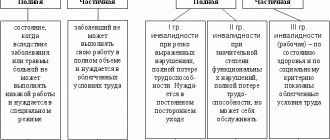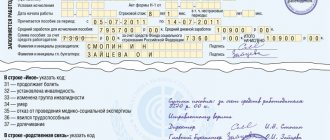“For the period” or “for the period”?
Both options are correct. The choice of preposition depends on the context:
1 “For a period” is appropriate to use in cases where we are talking about the entire period of time covered by the word “period”, in the meaning “from beginning to end”:
During the period of temporary incapacity for work of the section chief, his duties were assigned to the assistant section chief.
2 “During the period” is used in those sentences that talk about a specific event that occurred in a certain period of time.
During the period of temporary incapacity for work of the site manager, a minor but unpleasant incident occurred.
It is also possible to use the combination “for a period” if we are talking about several events (two or more) that occurred over a certain period:
During the period of temporary incapacity for work of the site manager, two employees were fired.
Limitation on the duration of sick leave in case of a canceled contract
The duration of paid sick leave upon cancellation of the contract is limited to 75 days (Clause 4, Article 6 of the Law “On Compulsory Social Insurance” dated December 29, 2006 No. 255-FZ). But if the cause of temporary disability is tuberculosis, then this restriction does not apply.
For comparison: if sick leave is issued by a full-time employee, then its duration for which benefits are paid can be (clause 11 of the order of the Ministry of Health and Social Development of the Russian Federation dated June 29, 2011 No. 624n):
- 15 days, if a certificate of incapacity for work is issued by the attending physician, as a rule, for a common disease, for example, an acute respiratory infection;
- 10 months, if sick leave (several sick leaves in a row) is issued by a medical commission, subject to a favorable work and clinical prognosis.
In case of tuberculosis, the duration of sick leave can be 12 months.
When is a comma used?
1 A comma is placed before the combination “during the period” if it opens a separate phrase with the meaning of clarification, addition, explanation . At the same time, “during the period” is not distinguished separately, but the turnover itself is isolated.
When she becomes very sad, during a period of complete loneliness, for example, she goes to a cafe, sits at a table near the window and drinks a sweet cappuccino, looking thoughtfully at the people passing by.
In this sentence, commas highlight the phrase “during a period of complete loneliness, for example,” but not the combination “during a period.”
Important! If the preposition is inside the phrase , then there is no need to highlight it separately.
I love walking on warm July nights, especially between eleven o’clock in the evening and two o’clock in the morning, when the heat accumulated during the day has not yet subsided.
2 Before and after the preposition “during the period,” a comma is sometimes placed if there are members of the sentence nearby that need to be isolated
During the period when the sun goes down behind the mountains, the sea looks especially beautiful. The comma is placed after “during the period” only because the subordinate clause “when the sun goes down behind the mountains” begins after it.
Victor, in order to financially support his parents, worked as a loader while studying at the university.
In this example, commas highlight the subordinate clause “to financially support parents.”
Dismissal at own request Employee
How to leave without detention, and what to do if you change your mind. In this publication, together with the Legal Alternative group of companies, we examine the issues of dismissal from the employee’s point of view.
Are you an employer? Then wait for the continuation!
In accordance with Article 80 of the Labor Code of the Russian Federation, an employee has the right to terminate an employment contract by notifying the employer in writing no later than two weeks in advance. The specified period begins the next day after the employer receives the employee’s resignation letter. Dismissal at one's own request is always initiated by the employee and involves sending a corresponding application to the employer.
It is worth remembering that it is imperative that the employee retains a copy of the application with a mark of acceptance by the employer.
How long is a quarter?
There are also four seasons, and each lasts 3 months. Does this mean that the concepts of “season” and “quarter” are identical? And under what circumstances is this possible? Indeed, a quarter also lasts 3 months. But he counts from the beginning of the year and further - in order, regardless of the season. We would observe a complete coincidence when celebrating the New Year, for example, on the first of March.
View gallery
This could also have been the case among the ancient Slavs, who celebrated the transition of the calendar in the fall. For them, the New Year began on the first of September.
So how many quarters are there in a year? There are four of them, let's call them by month (there are three of them) and compare them with the seasons.
| I (Q1) | January March | December - February (winter) |
| II (Q2) | April June | March-May (spring) |
| III (Q3) | July - September | June - August (summer) |
| IV (Q4) | October December | September - November (autumn) |
Date of dismissal in the application
The employee must indicate in writing a request to terminate the employment relationship. Only in the motive of the letter it is necessary to indicate not about your desire to resign, but the agreement of the parties must be indicated.
As for the date, the application for dismissal, by agreement of the parties, must be dated on the date that should have previously been agreed upon between the two parties.
If the employee does not indicate the date of dismissal in. then the company can do it for him in two weeks.
Having a number entered by the employee will completely eliminate any misunderstanding in the future.
Many employees make a mistake when drawing up a resignation letter.
When an employee resigns on his own, the company has no right to refuse to terminate the employment contract. The only thing is that you may need to work for two weeks in order to find a replacement during this time. But this period should be considered with some nuances.
Firstly, the two-week period begins to run at 00 hours 00 minutes of the day following the date the employer receives the application, and ends on the corresponding day of the week (part.
When you write, put this in. It must be in 2 copies. On the 2nd copy, put a stamp and signature from the secretary of the person who accepted the application and take it for yourself.
An employee has the right to terminate an employment contract by notifying the employer in writing no later than two weeks in advance, unless a different period is established by this Code or other federal law. The specified period begins the next day after the employer receives the employee’s resignation letter.
In cases where the employee’s application for dismissal on his initiative (at his own request) is due to the impossibility of continuing his work (enrollment in an educational institution, retirement and other cases), as well as in cases of established violation by the employer of labor legislation and other regulatory legal acts, containing labor law norms, local regulations, terms of a collective agreement, agreement or employment contract, the employer is obliged to terminate the employment contract within the period specified in the employee’s application.
Before the expiration of the notice period for dismissal, the employee has the right to withdraw his application at any time.
My relationship with my superiors deteriorated, and I wrote a letter of resignation. He brought it to his immediate superior, who put it on the table. Then I sent the application to the head of the organization by mail in a valuable letter. There is no reaction, no access to the manager, no notification yet.
Why is division into quarters necessary?
Having decided how many quarters there are in a year, you should figure out why and who needs such a division. Any production needs planning of its activities and summing up its results. Statistics and financial statements are used for this purpose.
During the financial year, it is necessary to be able to draw intermediate conclusions and adjust certain indicators. A month is too short a period of time for this. Therefore, neighborhoods have become an established tradition in the world.
The number of months in them is the same, but the days are not. The fewest of them are in the first quarter - 90. In a leap year - 91. The same number in the second quarter. The most days in the next two are 92. This brings certain inconveniences, so the world community has been discussing the possibilities of a different financial calendar for more than a century.
View gallery
But so far no alternative has been created, because the modern Gregorian calendar is closest to the astronomical one.
Competent application for resignation of one's own free will
To do this, he must notify his employer 2 weeks before the expected date of dismissal. In Art. 80 of the Labor Code of the Russian Federation states that the form of notification must be written.
A notice is a statement from an employee with a request to dismiss him at his own request on a certain date.
If the employee is on a probationary period, he can notify the employer 3 calendar days in advance.
The period begins the day after the employer receives the application. In the application, the employee expresses his desire to leave the employer on his own initiative on a certain date. For example, the wording of the statement could be as follows:
“I ask you to dismiss me voluntarily on June 15, 2015”
There are probably very few people who have never changed jobs.
Employing organizations also do not flatter themselves with hopes that all their employees will work for the company forever. In the personnel selection environment, the concept of “acceptable level of staff turnover” has long been known, which does not need to be deciphered.
Career growth and an interesting offer, relocation, the desire to try yourself in a new place, the desire for development - completely different reasons lead to the fact that on the manager’s desk, in the end, there is a sheet of paper with several lines of text and three main words among them: “Please fire me.” This is exactly how, in most cases, what happens in the Labor Code is the termination of an employment contract at the initiative of the employee.
A separate article of the Labor Code, number 80, is devoted to the dismissal of an employee at his own request.
Origin of the term "quarter"
The word is of Latin origin and has become part of the German language. It is literally translated as “quarter”. The very meaning of the term seems to carry the answer to the question of how many quarters there are in a year. There are four of them, because we are talking about the fourth part.
In the Russian Federation, this period is usually denoted by Roman numerals: IV, III, II, I. And in English-speaking countries (including the USA) - by Arabic numerals, preceded by the Latin letter Q. For example, Q4. This unit of measurement is used in economic statistics and accounting to summarize the interim results of the year.
View gallery
Comparison with other viruses
The incubation period for the new coronavirus COVID-19 is longer than for classic viral respiratory diseases.
For comparison, epidemiological data for various variants of ARVI:
- seasonal flu - from several hours to 1-2 days;
- rhinovirus infection - 1-6 days;
- respiratory syncytial infection - 3-7 days;
- typical coronavirus infection - 2-5 days.
For SARS, caused by other coronavirus variants, the latent period is 2-7 days (for SARS) and about 5 days (for MERS).
Russian
| Wikidata has the lexeme period (L142713). |
Morphological and syntactic properties
| case | units h. | pl. h. |
| Them. | period | periods |
| R. | period | periods |
| D. | period | periods |
| IN. | period | periods |
| TV | period | periods |
| Etc. | period | periods |
pe-ri-od
Noun, inanimate, masculine, 2nd declension (declension type 1a according to the classification of A. A. Zaliznyak).
Root: -period- .
Pronunciation
- MFA: units h.
pl. h.Semantic properties
Meaning
- the period of time during which a cyclic process completes a full cycle of changes ◆ A number of phenomena on Earth repeat themselves with the period of rotation of the Sun (about 27 days). ◆ The measurement cycle is repeated with a period of 1 second.
a period of time as a stage, a stage of some process ◆ The post-war period became for her a period of unprecedented success. ◆ It is generally accepted that during the Soviet period, Russian philosophy had no prospects for its development. ◆ There was a period in my life when I became addicted to coffee, almost like a drug addict.
- sport. a separate, isolated part of a match in hockey and some other team games ◆ In the first period, our team had an advantage; in the second period there were a lot of deletions; which in turn ruined the game; in the third period our hockey players played strictly on the defensive, trying not to allow the opponent to enter the active zones.
- math. a non-zero quantity (usually the smallest positive value), the addition of which to the argument of a periodic function does not change the values of this function ◆ A good example of periodic functions are the trigonometric functions y = sin x, y = cos x (the period of these functions is 2π).
- math. an infinitely repeating sequence of digits after the decimal point in the positional notation of a rational number ◆ When dividing into a column of 1 by 7, all remainders from 1 to 6 will be found, and in the period there will be a six-digit number 142857.
- outdated, linguistic the same as a sentence ◆ A period concludes a whole period, and is usually followed by a capital letter, which also begins honorable and proper names. M. V. Lomonosov, “Russian Grammar”, 1755 (quote from the National Corpus of the Russian Language, see References)
- geol. the period of time during which the layer of rocks that formed the corresponding geological system was deposited ◆ Even in the Jurassic period, there were numerous lakes in Central Asia and lush vegetation on their shores, judging by the presence of coal seams in the Jurassic strata. V. A. Obruchev, “In the wilds of Central Asia,” 1951 (quote from the National Corpus of the Russian Language, see References)
Synonyms
- partial: cycle
- phase, segment, cycle, epoch
- —
- —
- —
- —
- geological period
Antonyms
- —
- —
Hypernyms
- interval
- time, interval
Hyponyms
- year, day; photoperiod
Holonyms
- —
- —
- —
- —
- —
- —
- era
Meronyms
- —
- —
- —
- —
- —
- —
- era
Related words
Closest relationship
Etymology
Comes from ancient Greek. περίοδος “circle, detour; rotation", from περί "around, about; o" + ὁδός "road, path", from Proto-Indo-Hebrew. *ked-/*sed- “to walk.” In most European languages, the word is borrowed. from Greek via lat. periodus. Russian period - starting with Peter I, borrowed. via French period from lat. Data from M. Vasmer's dictionary were used. See References.
Phraseologisms and stable combinations
- geological period
- Devonian
- Cambrian period
- glacial period
- half life
- refractory period
- tertiary period
- quaternary period
- Jurassic period
- ordinary period
- period of oscillation
Translation
full cycle time
- Englishen: period
- Swedishsv: period (sv) general.
interval
- Englishen: period
- Swedishsv: period (sv) general.
interval on the x-axis
- Englishen: period
- Swedishsv: period (sv) general.
Bibliography
- Martemyanov Yu. S. Notes on the structure of the situation and the form of its description // Machine translation and applied linguistics: Vol. 8 M.: I MGPIYA, 1964, p. 128.
- Martemyanov Yu. S. Notes on the structure of a situation and the form of its description // Martemyanov Yu. S. Logic of situations. Text structure. Terminology of words M.: Languages of Slavic culture, 2004, p. 105.
| (file) |
To improve this article it is desirable:
|
Content: emphasis in the word “PERIOD”
- Definition and analysis of the word
- Which is correct – “period” or “period”?
- Examples for reinforcement
“PERIOD” is an inanimate noun that is derived from the Latin word “periodus”.
The word is commonly used and there are often difficulties with correct pronunciation.
Let's figure this out.
First, let's break the word into phonetic syllables:
period
The word “period” has 3 syllables, 6 letters and 6 sounds.
So which syllable will be stressed in this case?
In colloquial speech there are two options for pronunciation of the analyzed word:
- “period”, where the stress falls on the vowel “i” of the second syllable,
- “period”, where the stress falls on the vowel “o” of the third syllable.
7.1. Rules for dating facts
7.1.1. Converting dates from Old Russian chronology to modern
To do this, you need to subtract one of three numbers from the chronicle year (5507, 5508, 5509), depending on the month of the event and the calendar style used in the chronicle - with the beginning of the new year on March 1 or September 1.
Select one of three numbers - according to the following table:
| Fact month | Start of the New Year | |
| March 1 | 1 Sep. | |
| Jan. - Feb. | 5507 | 5508 |
| March - Aug. | 5508 | 5508 |
| Sep. - Dec. | 5508 | 5509 |
Eg:
19 Dec. 7208 (beginning of year September 1): 7208 - 5509 = December 19 1699
If the calendar style is unknown, that is, it is not known whether the year begins on March 1 or September 1, you need to subtract 5508 from the chronicle date (the date will be approximate).
If the month of the fact is unknown, which does not allow us to accurately determine the year according to modern chronology, then, according to the “Rules for the publication of historical documents in the USSR,” the year is designated by two adjacent years separated by a fraction. Eg:
7090 = 7090 - 5508 = 1582; the date is indicated as 1581/82.
↑ Contents ↑
7.1.2. Converting dates from old style to new
To do this, you need to add one or another number of days to the old style date, depending on the period in which the fact being described falls, according to the following table:
| Period (from 01.03 of the first year to 29.02 of the last) | Amendment, day | Period (from 01.03 of the first year to 29.02 of the last) | Amendment, day |
| 400—500 | +1 | 1300—1400 | +8 |
| 500—600 | +2 | 1400—1500 | +9 |
| 600—700 | +3 | 1500—1700 | +10 |
| 700—900 | +4 | 1700—1800 | +11 |
| 900—1000 | +5 | 1800—1900 | +12 |
| 1000—1100 | +6 | 1900—2100 | +13 |
| 1100—1300 | +7 |
For example: 15 Feb. 1300 Period 1100-1300 (until February 29 of the last year) + 7, i.e. February 22. 1300
↑ Contents ↑
7.1.3. Facts dating according to the old style
These are facts relating to the history of Russia before the February Revolution (February 27, 1917). In Russia, the new style (n.st.) was introduced by the decree of the Council of People's Commissars of 01/25/18, which established the day after 01/31/18 to be considered February 14. (and not the 1st), because the difference between styles in the 20th century. 13 days.
↑ Contents ↑
7.1.4. Facts dated according to the new style
These are the facts relating to:
1. To the history of foreign countries and international life.
2. To the history of our country from February 14. (February 1, Art. Art.) 1918 (day of introduction of the New Art. Art. in it).
↑ Contents ↑
7.1.5. Facts dating from both the old and new styles
Double dates are placed if the date refers to:
1. To the pre-revolutionary history of Russia, but to events abroad.
2. To the history of Russia from the February Revolution (February 27, 1917) to February 14 (1st Art.). 1918 For example: October 25 (November 7), 1917
Note. The recommendation does not concern the dating of the source. documents, since the “Rules for the publication of historical documents in the USSR” require dating according to the present day. Art. only documents drawn up in Russia from February 1. 1918
3. For letters sent from abroad to Russia before February 14. 1918 Next to the date according to present day. Art. put the date in parentheses according to Art. Art. Eg: Naples, 10 Jan. 1848 (29 Dec 1847).
Note. It is acceptable if letters are published (not correspondence between Russian and foreign correspondents), when adding the words n to the date. Art. Do not put the date in square brackets according to Art. Art. For example: 10 Feb. [n. Art.] 1851
↑ Contents ↑
7.1.6. Use of words BC e. or n. e.
If the fact refers to a time before the initial (initial) moment of our chronology, next to the date it is necessary to put the words BC. e. (BC).
To avoid confusion, it is recommended to accompany the dates of the first years (centuries) of our era with the words n. e. (ad). For example: 26 Feb. 747 BC e.; Aug 29 284 AD e.; III century BC e.; II century n. e.
↑ Contents ↑
7.1.7. Anniversary of events that took place before our era
In order to correctly calculate the round anniversary date of an event that took place BC. e., the number of years BC should be subtracted from this date. e. and add one to the resulting number. The unit has to be added because if you simply add up the date of an event that occurred BC. BC, with a modern date, then the amount will include year zero at the beginning of AD. e., but there was no such year.
Example. You need to find out in what year it was 2,000 years since the birth of Alexander the Great (born in 346 BC).
2 000 — 346 = 1 654 + 1 = 1 655
1655 marked 2,000 years since the birth of Alexander the Great. Not in 1654 because from the beginning of the century. e. Not 1654 passed, but 1653 (without a zero year), i.e. in 1654 only 1,999 years were completed.
Another way to calculate: to the modern year, add the date of the event that occurred BC. e., if the sum is a round number plus one, then the modern year can be considered a jubilee year.
Example. Ovid was born in 43 BC. e. Let's say we have 1958. 1958 + 43 = 2,001. This means that in 1958 it was 2,000 years since the birth of Ovid
In accordance with this, in 1998 there are round dates for events that occurred in 3, 103, 203. BC e.: 1998 + 3 = 2001; 1998 + 103 = 2101; 1998 + 203 = 2201, etc.
↑ Contents ↑







